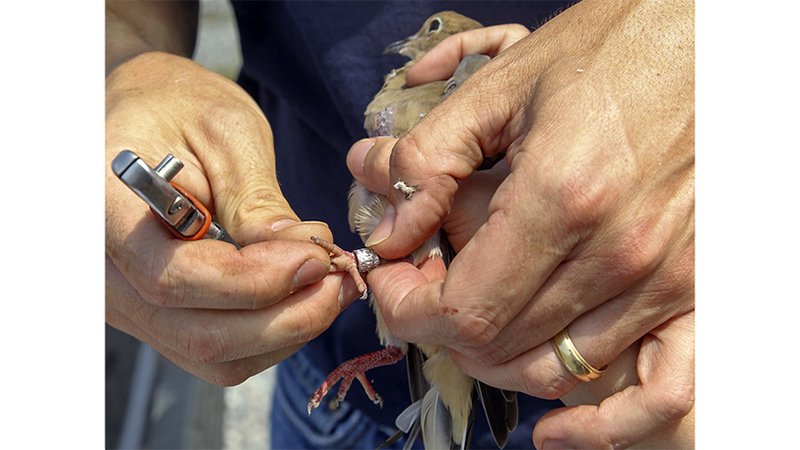Get HIP and be on the lookout for banded doves Sept. 1
ON 08-29-2018

Aug. 29, 2018
Randy Zellers
Assistant Chief of Communications
LITTLE ROCK – With the kickoff to hunting season coming in the form of the dove season opener this Saturday, hunters are reminded to check their licenses to ensure they’ve registered for the Harvest Information Program. If not, it only takes a few minutes through the AGFC’s license system at www.agfc.com/license.
They should also be on the lookout for doves sporting a leg band.
Ducks and geese aren’t the only game birds hunters may score a leg band from during hunting season. Arkansas Game and Fish Commission biologists use leg bands for population research on many game birds, including mourning doves.
“The Harvest Information Program and banding programs work hand-in-hand to monitor populations,” said AGFC Waterfowl Program Coordinator Luke Naylor. “We have a half-dozen dove banding stations that operate similar to duck banding stations.”
Naylor explains that the actual formulas for determining populations are complex, but the bands returned versus the total number of birds banded can give a rough estimate of the total population when the harvest is known.
“We get a harvest estimate based off HIP surveys,” Naylor said. “Not the quick list of questions you answer when you get the HIP permit, but more in-depth hunter diaries that are sent to a random selection of hunters after they sign up for the permit. Harvest estimates and harvest rates from banded birds are combined to calculate population estimates.”
Naylor says band returns are critical for population estimates because other methods of estimation have been abandoned over the decades.
“It’s the only regular method we have to measure dove population status,” Naylor said. “For years, we did a call count survey, where biologists would drive specific routes and listen for doves calling before the season. You then take that number and use statistics to derive a population estimate.”
In addition to being extremely labor intensive, the call count method of population estimation faced the drawback of shifting flight patterns because of habitat changes.
“One of the historic routes I inherited from previous biologists has changed from open fields in rural Arkansas to suburban and urban areas where traffic noise and other factors make it more difficult to see or hear the birds.”
Naylor says there still is a modified call count survey available for use, but the band return system is the current standard in place.
“You may get up to 60 doves banded in one afternoon at a good banding station location,” Naylor said. “So it’s much less labor intensive than having 20 biologists running 20 different routes throughout the state multiple times.”
The doves are trapped in a walk-in style trap, similar to a minnow trap.
“There are a couple of entry points that are funnels toward a bit of bait,” Naylor said. “Once the dove goes in, it can’t come back out. We collect them, get data on the birds, band them and release all within a few minutes.”
The doves will disperse from the banding station, and where they are harvested will give biologists a good idea of movements and survival each year.
“It’s really important to look at your birds when you’re cleaning them for a band,” Naylor said. “It’s a small gray band on a gray bird, so it’s not as obvious as a leg band on a mallard. Hunters also are not conditioned to look for a band as soon as they harvest one like they do a duck.”
Bands can be reported through the same site as duck band returns: www.reportband.gov.
Recent News
Subscribe to Our Weekly Newsletter E-mails
Don’t miss another issue. Sign up now to receive the AGFC Wildlife Weekly Newsletter in your mailbox every Wednesday afternoon (Waterfowl Reports are published weekly during waterfowl season and periodically outside the season). Fishing Reports arrive on Thursdays. Fill in the following fields and hit submit. Thanks, and welcome!


